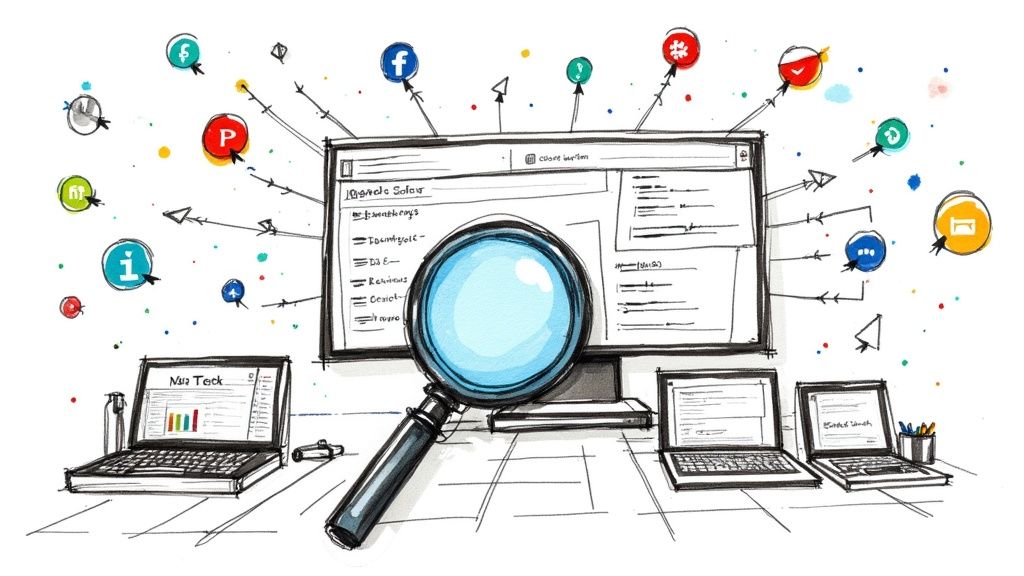8 Online Reputation Management Best Practices for a Stellar Online Presence
Online reputation is often the first impression potential customers have of your business, and it can make or break your success. Managing your online presence is essential.
- 13 min read

Protecting Your Brand: Why Online Reputation Matters
Your online reputation directly impacts your business success. Customer opinions now spread instantly through review sites and social media, reaching thousands of potential customers in minutes. For any business - from local shops to growing companies - managing your online presence has become essential for long-term success.
The practice of reputation management has changed dramatically from its PR-focused roots. Today, it combines customer service, search engine optimization, social media engagement, and customer psychology. Success requires actively participating in online conversations, gathering positive reviews, responding professionally to feedback, and maintaining an authentic brand voice across all channels.
This guide covers 8 proven strategies for building and protecting your online reputation. You'll learn practical ways to strengthen your digital presence, turn happy customers into vocal supporters, and handle challenging situations professionally. By following these core principles, you'll be better equipped to both safeguard your brand and leverage a positive reputation to fuel business growth.
1. Proactive Content Creation & SEO
Your online presence shapes how people perceive your brand. Creating content strategically and optimizing it for search engines helps you take control of your brand's story online. This proactive approach lets you build authority and minimize negative content's impact.

How It Works:
Creating content strategically involves several key elements:
- Keyword Research & Optimization: Find and target the exact terms your potential customers use to search for businesses like yours
- Building Strong Web Properties: Create and maintain your website, blog, and social media profiles as hubs for sharing your story
- Regular High-Quality Content: Publish helpful articles, videos, and other content that your audience finds valuable
- Smart Content Distribution: Share your content across multiple channels to reach more people
With more consumers checking reviews and social media before making decisions, taking charge of your online narrative has become essential for business success.
Real Examples in Action:
Take Microsoft's journey - they transformed from being seen as the "evil empire" to an innovation leader by focusing on developer content and open-source initiatives. HubSpot became the go-to resource for marketing advice through consistent, high-quality blog posts, guides and training materials.
Benefits:
- Results that last: A strong content foundation builds lasting online visibility
- Natural authority growth: Regular, valuable content establishes your expertise
- Control over your story: Shape public perception before issues arise
Challenges:
- Takes time to see impact: SEO and content marketing require patience
- Needs ongoing work: Creating quality content demands regular effort
- Resource requirements: Good content creation needs investment in skills and tools
Practical Steps to Get Started:
- Research your key terms: Find the exact words your customers use when searching
- Set a content schedule: Post new content regularly to stay relevant
- Target featured snippets: Structure content to appear in Google's highlighted results
- Mix content types: Use articles, videos, and images to engage different audiences
- Consider using the AI Blog Ideas Generator to help brainstorm topics
By following these guidelines, businesses of all sizes can build their online reputation through strategic content. While it requires consistent effort, the long-term benefits make it worthwhile.
2. Social Media Monitoring & Engagement

Your brand's reputation lives and breathes on social media. Just like a physical store needs staff to help customers, your online presence needs active management and engagement. By monitoring social conversations and engaging with your audience, you can shape how people see your brand while building real connections with customers.
Monitoring means keeping track of brand mentions, key terms, competitor activity and relevant hashtags across social platforms. The next step is engagement - jumping into conversations, answering questions, and addressing concerns. This two-way communication has become essential as more customers turn to social channels for support and feedback.
Key Monitoring & Engagement Tools:
- Real-time tracking: See and respond to mentions as they happen
- Custom alerts: Get notified instantly about important conversations
- Response templates: Save time with pre-written answers for common questions
- Sentiment tracking: Understand the overall tone of brand discussions
Benefits:
- Quick issue detection: Address problems before they grow
- Personal customer connections: Build relationships through direct interaction
- Community building: Create trust through consistent, authentic engagement
Challenges:
- Always-on requirement: Social media runs 24/7
- High message volume: Large brands face overwhelming amounts of mentions
- Response risks: Poor replies can damage reputation
Real Examples in Action:
- Wendy's: Uses humor and quick wit on Twitter to create a memorable brand voice
- Nike: Shows how to handle public discussions around controversial topics
Making It Work:
- Set up thorough tracking across all key platforms
- Create clear response guidelines for your team
- Train staff on handling negative situations
- Write personal, thoughtful replies instead of generic responses
When done right, social monitoring and engagement helps businesses of all sizes build stronger customer relationships and maintain a positive online reputation. The key is consistency, authenticity, and a real commitment to serving your community.
3. Review Management Strategy
Online reviews significantly shape how customers view and choose businesses. A well-planned approach to handling customer feedback across different platforms helps build credibility and bring in new customers. Reviews directly impact business growth by influencing potential customers' decisions.
A solid review management plan includes these key parts:
- Review Tracking Tools: Keep tabs on what customers say about your business across Google, Yelp, Facebook, and industry sites. Quick responses show customers you care about their feedback.
- Response Guidelines: Create clear steps for responding to both good and bad reviews professionally. This shows customers you take their input seriously.
- Review Collection Process: Ask happy customers to share their experiences. Set up automated emails, in-store requests, or small incentives to encourage reviews.
- Review Analysis: Study review data to spot trends and areas needing improvement. Use this information to make smart business changes.
Here's what good review management can do:
- Builds Customer Trust: Good reviews serve as social proof, helping new customers feel confident choosing your business.
- Boosts Search Results: Review quality affects search rankings. Better reviews can help more people find your business online.
- Gives Direct Feedback: Reviews tell you exactly what customers like and dislike, helping you improve your business.
Common challenges include:
- Takes Time: Keeping up with reviews on multiple sites requires dedicated effort.
- Limited Platform Control: While you can join the conversation, you can't control everything said about your business online.
- Lasting Negative Reviews: Even with good responses, negative reviews stay visible and may affect future customers.
Real businesses show how review management works. Airbnb lets hosts respond to guest reviews publicly, showing they care about guest satisfaction. Amazon's verified purchase badges make reviews more trustworthy for shoppers.
Tips for Managing Reviews:
- Quick Responses: Answer reviews promptly to show you value feedback.
- Ready-to-Use Replies: Create basic response templates you can customize.
- Ask Happy Customers: Make it simple for satisfied customers to leave reviews.
- Handle Problems Well: When responding to negative reviews, acknowledge issues, apologize, and offer solutions.
Reviews have become key factors in purchase decisions. For businesses of all sizes, actively managing reviews is essential to maintain a strong reputation, attract customers, and grow steadily.
4. Crisis Management Protocol

A single negative incident can quickly spread online and seriously damage your company's reputation. Having a solid Crisis Management Protocol helps businesses respond effectively when problems arise. This plan outlines specific steps for handling negative publicity and protecting your brand image during difficult situations. Good preparation can make the difference between a minor setback and major damage to your business.
A well-designed Crisis Management Protocol includes these key elements:
- Crisis Communication Plan: Specifies internal and external communication procedures, designated spokespersons, channels to use, and key messaging
- Stakeholder Management: Identifies important groups (customers, employees, investors, media) and plans for engaging with each during a crisis
- Media Response Strategy: Details how to handle media inquiries, prepare statements, conduct press conferences, and manage social media
- Recovery Procedures: Outlines specific steps to rebuild trust and repair reputation after the crisis passes
The importance of crisis management became clear in the late 20th century as mass media grew. The 1982 Johnson & Johnson Tylenol crisis showed how quick, transparent action could save a brand - they recalled products immediately and communicated openly with the public. In contrast, BP's handling of the Deepwater Horizon spill demonstrated how poor crisis response can make things much worse. A more recent example is KFC's "FCK" campaign, which used humor effectively to address a supply chain problem and actually generated positive coverage.
Pros:
- Keeps Teams Focused: Having a clear plan prevents panic and allows decisive action
- Creates Clear Message: Consistent communication across channels builds credibility
- Limits Reputation Damage: Quick, effective response contains negative impact
Cons:
- Needs Ongoing Updates: Crisis plans must be regularly reviewed and revised
- Can't Cover Everything: While you should plan for likely scenarios, unexpected situations will arise
- Timing Critical: Even great plans fail if not implemented quickly
Tips for Implementation:
- Set Up Communication Systems: Create clear channels for information flow during crisis situations
- Plan for Common Problems: Develop responses for likely issues like product problems, data breaches, and social media backlash
- Practice Regularly: Run crisis drills so teams know their roles and responsibilities
- Build Strong Relationships: Good connections with stakeholders help manage crises more smoothly
With proper planning and regular review of your Crisis Management Protocol, you'll be ready to handle reputation challenges and protect your brand when problems occur.
5. Digital Asset Optimization
Digital Asset Optimization (DAO) helps businesses organize and manage their digital properties effectively - from websites and social media to images, videos, and logos. For small businesses and startups building their online presence, proper asset management is key to maintaining a strong brand identity that resonates with customers.
Good asset optimization creates a professional, unified brand experience that directly impacts how customers perceive and interact with your business. When done right, it builds trust and encourages purchasing decisions.
Key Elements of Digital Asset Optimization:
- Brand Consistency: Keep your voice, messaging, and visuals (logos, colors, fonts) aligned across all platforms
- Asset Management: Use a central system to store and organize digital files
- Domain Management: Protect your brand by managing domain names strategically
- Visual Content: Optimize images and videos for better performance and user experience
Benefits:
- Brand Trust: Creates a consistent experience that builds recognition
- Asset Protection: Centralized management helps prevent unauthorized use
- Better Discovery: Properly optimized assets improve search visibility
Challenges:
- Cost: Quality asset management systems require investment
- Management: Requires ongoing attention and organization
- Regular Updates: Needs consistent maintenance to stay current
Success Stories:
- Coca-Cola manages their global brand assets through a unified system
- Disney actively protects their digital properties and brand integrity
Implementation Tips:
- Conduct regular audits of your digital assets
- Use strong security to protect brand materials
- Follow brand guidelines consistently
- Consider using asset management tools to streamline workflow
For growing businesses and marketers, DAO provides a framework to control your brand narrative and strengthen your online impact. Well-managed digital assets help build credibility and trust with customers.
Read also: [Effective Strategies for Requesting Customer Reviews]
6. Competitive Intelligence Monitoring
Being smart about tracking your competition has become essential for managing your brand's reputation online. It's about understanding your competitors' actions, public perception, and tactics to make better decisions for your own business.
Competitive monitoring helps you learn from others' wins and losses, giving valuable context to shape your own reputation strategy.
Key Components of Competitive Intelligence:
- Tracking Tools: Software that automatically monitors competitor activity across websites, social media, and reviews while measuring their performance metrics
- Market Research: Deep analysis of industry trends, customer needs, and how competitors position themselves
- Performance Comparison: Regular reports measuring your reputation metrics against competitors to spot improvement areas
- Strategic Updates: Using gathered insights to adjust your approach and strengthen your market position
Benefits:
- Finds Growth Areas: Spotting competitor gaps reveals chances to gain customers and market share
- Better Decision Making: Understanding competitor moves helps predict trends and improve your messaging
- Risk Reduction: Learning from others' mistakes helps protect your reputation
Challenges:
- Cost Factors: Quality monitoring tools and research can be expensive for smaller companies
- Limited Information: Some competitor data isn't publicly available or may be hard to interpret
- Loss of Focus: Too much attention on competitors can distract from your core goals
Real Example: A restaurant notices through review monitoring that its nearby competitor gets frequent complaints about slow service. The restaurant then improves its own service speed and promotes quick service as a key benefit, helping it win more customers.
Growth of Competitive Monitoring: The rise of social media and review sites has made tracking competitors easier than ever. Companies now have access to more public data about their competition's performance and customer feedback.
Tips for Success:
- Set Clear Goals: Know exactly what you want to learn from monitoring competitors - whether it's improving service, visibility or market share
- Use Multiple Sources: Combine data from different tools and research to get a complete picture
- Focus on Useful Insights: Don't just collect data - analyze it to find actionable ways to improve
- Update Regularly: Review competitive data often and adjust your approach as needed
By making competitive monitoring a priority, you can better understand your market position and make smarter decisions to grow your business and protect your reputation.
7. Employee Advocacy Program
Your employees are your best brand ambassadors. An Employee Advocacy program gets your workforce sharing positive experiences and company content, helping build trust and expand your online presence organically.
Social media gave this practice a huge boost. As platforms like LinkedIn, Twitter, and Facebook became key business channels, companies discovered the power of employee networks. People trust content from real employees more than official corporate messaging.
How Does It Work?
A strong Employee Advocacy program needs these key elements:
- Clear Guidelines: Set standards for brand voice, acceptable topics, and what to avoid. This maintains message consistency while minimizing risks.
- Content Hub: Give employees easy access to pre-approved content they can share with their networks.
- Training Support: Teach social media best practices and brand messaging so employees feel confident as company representatives.
- Rewards System: Recognize and incentivize participation through rewards or gamification to boost engagement.
Real-World Success Stories
- Dell's Social Media University: Provides in-depth social media training to turn employees into effective brand voices.
- Adobe's Social Shift: Encourages staff to share their enthusiasm for Adobe products and culture across social networks.
Benefits
- Natural Brand Voice: Employee content feels more genuine than corporate messaging
- Wider Reach: Tap into employees' combined social networks to find new audiences
- Budget-Friendly: Much lower cost than traditional advertising for similar impact
Challenges
- Ongoing Management: Requires dedicated resources to run effectively
- Message Control: Risk of employees sharing incorrect or inappropriate content
- Training Investment: Need regular updates to keep employees current on best practices
Implementation Tips
- Document Clear Rules: Create thorough social media guidelines covering brand voice and content standards
- Make Sharing Simple: Provide ready-to-share content employees can easily post
- Keep Training Fresh: Hold regular sessions to reinforce guidelines and address questions
- Track Results: Monitor key metrics like reach and engagement to measure impact
Why This Strategy Matters
Building real trust with customers is essential for business success. Employee Advocacy gives your brand an authentic human voice while expanding your reach naturally. This makes it valuable for organizations of all sizes looking to strengthen customer relationships through genuine engagement.
8. Reputation Measurement & Analytics

Smart businesses know that tracking and analyzing their online reputation is essential. By measuring how people perceive your brand, you can make smarter decisions about improving your image and protecting your company's good name. The right measurement tools turn reputation management from guesswork into a data-driven practice.
Having a clear system for monitoring your online presence helps you understand what customers really think. Beyond just counting stars in reviews, proper analytics reveal the deeper reasons behind customer feedback.
Key Features of Reputation Measurement:
- Sentiment Analysis: Uses advanced language processing to understand the emotions and specific topics driving customer opinions
- Share of Voice: Measures how much online discussion about your industry focuses on your brand versus competitors
- Impact Assessment: Evaluates if your reputation strategies are improving customer sentiment and sales
- ROI Tracking: Links reputation management efforts to business results like conversion rates and customer value
Benefits:
- Better Decision Making: Replace hunches with data-backed insights
- Measurable Results: See concrete proof of reputation management success
- Early Warning System: Spot potential issues before they become crises
Challenges:
- Technical Setup: Creating a complete measurement system requires significant effort
- Tool Requirements: Advanced features need specialized software
- Budget Impact: Professional measurement tools can be a notable expense
Real Examples:
- Apple's Customer Loyalty: Tracks Net Promoter Score (NPS) to measure how likely customers are to recommend their products
- Tesla's Social Monitoring: Uses social listening to understand public discussions and adapt messaging
Implementation Tips:
- Choose Clear Metrics: Pick KPIs that match your business goals, like satisfaction scores and review ratings
- Use Multiple Tools: Combine different data sources for a complete view
- Set Regular Reports: Create a consistent schedule to track progress
- Focus on Action: Collect data that helps improve your strategies
The way companies measure reputation has changed dramatically. While businesses once relied on occasional surveys, they now have access to constant streams of online feedback. This wealth of data lets companies of all sizes understand and shape their public image with greater precision than ever before.
Online Reputation Management Strategies: A Comparative Overview of 8 Best Practices
Taking Control of Your Online Narrative
Building a positive online reputation requires consistent effort and attention. The most effective approach combines eight key practices: proactive content creation with SEO, social media engagement, review management, crisis protocols, digital asset optimization, competitor monitoring, employee advocacy, and performance analytics. When implemented properly, these elements help shape your brand's story online and build lasting trust with customers.
The foundation lies in four core principles: be proactive, authentic, responsive, and persistent. Make these practices part of your daily operations. Set aside dedicated time for monitoring social conversations, creating content, and responding to reviews. Ensure your team understands crisis procedures and can confidently represent your brand.
Success requires measuring what works and adapting as needed. Regularly review your reputation metrics and results. Pay attention to new developments like video content gaining prominence, emerging social platforms, and search engine changes. Being willing to adjust your approach helps maintain an effective strategy.
Key Takeaways:
- Proactive Management: Take charge of your online presence before issues arise
- Authentic Engagement: Build real connections through genuine interactions
- Consistent Monitoring: Stay alert and address concerns promptly
- Data-Driven Decisions: Use metrics and insights to guide your strategy
Your online reputation directly impacts business success. Give it the attention it deserves. Looking to simplify review collection and showcase positive feedback? kisReviews provides comprehensive tools to gather and display customer reviews across platforms like Google and Yelp. Features include automated review requests, QR codes, and website widgets to help manage your online presence. Try the free plan or explore enterprise options - visit kisReviews today to start building your reputation.
